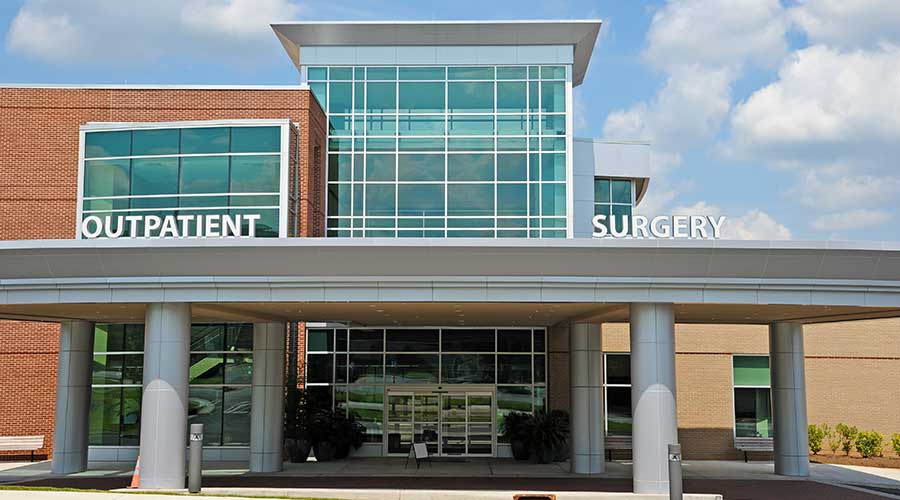Although people 55 years old and older comprise only 30 percent of the U.S. population, they are the biggest consumers of U.S. healthcare services, and people 80 and older are forecasted to balloon nearly 50 percent in the next 10 years. The growth of the elder population in the United States, longer life expectancies and better healthcare delivery are fueling demand for outpatient healthcare facilities and services, reinforcing medical offices as one of the most stable asset classes.
Healthcare as a share of the U.S. gross domesticate product (GDP) was 19.7 percent in 2020, according to the Centers for Medicare and Medicaid Services. Along with healthcare expenditures, it is predicted to account for 30 percent of GDP by 2030. Outpatient demand for people 55 and older alone is forecast to grow 16.9 percent by 2025, a rate that is 4.3 percent higher than for the general population.
"If we consider that the older population will potentially grow from 46 million residents in 2020 to 80 million in 2050, we can anticipate that the demand for healthcare services and facilities will grow steadily and significantly,” says Jay Johnson, U.S. practice leader for healthcare markets with JLL. “We expect the elder population to drive significant outpatient demand over the next 10 years, which, in turn, is a fundamental driver for healthcare-related real estate despite the potential offsetting effects of telehealth and home care.”
Outpatient services typically include services, procedures and treatment that do not require hospital admittance, and this includes x-rays or other imaging, minor surgeries, bloodwork, routine visits in a medical office setting with a healthcare provider and counseling services.
JLL’s most recent Healthcare and Medical Office Perspective details the way outpatient sites dominate healthcare services delivery compared to hospital admissions. Also, outpatient revenue rose 8 percent in 2022, according to Kaufman Hall, while inpatient revenue was flat compared to 2021.
Additionally, up to one-third of hospital revenue is activity shifting to ambulatory surgery centers, office-based labs and other ambulatory sites, while inpatient discharges continue to decline due to regulatory changes, competition among healthcare systems in high-growth markets and technological innovation fueling a shift to outpatient settings.
“More sophisticated procedures can be done in outpatient settings than was possible a decade ago,” says Amber Schiada, head of Americas work dynamics and industry research with JLL. “Innovation in care combined with reimbursement pressures are driving a sustained shift to outpatient facilities, and consumer preferences for outpatient care have increased as well, as outpatient facilities are often more accessible or conveniently located. Furthermore, experience shows that outpatient locations are less expensive to build and operate, produce better-quality medical outcomes and yield higher rates of patient satisfaction.”
Medical offices and clinics are expected to receive the biggest share of growth. The Advisory Board estimates the medical office segment will welcome more than 585 million patient visits in 2025 and more than 635 million visits by 2030.
“Hospital outpatient, ambulatory surgery, laboratory services, physical therapy, emergency medicine and oncology centers will all benefit from outpatient growth, as do patients who seek more convenient and accessible care,” says Alison Flynn Gaffney, president of the healthcare division with JLL. “Reimbursement policies will continue to support this shift, and specialized care options will further drive competition within the industry.”
JLL Research also anticipates outpatient volume will accelerate across all markets, led by Sun Belt markets. JLL identified Austin, Phoenix, Raleigh, Las Vegas and Jacksonville as the top five growth markets based on anticipated outpatient volume between 2020 and 2025 and outpatient growth. This growth is consistent with the trend of the U.S. aging population migrating to Sun Belt markets. Austin, Raleigh, Dallas, Las Vegas, and Atlanta are the top five growth markets for those 55 years old and older.
Sun Belt markets also lead when it comes to medical office construction and, like many regions, have seen the continued transition to outpatient facilities.
“The aging population, along with the pandemic, have accelerated the migration from acute care facilities to more local outpatient clinics,” says Dan Squiers, senior vice president and national healthcare lead with JLL project and development services. “We have seen health systems merge or consolidate because of the pandemic. Labor shortages, supply chain disruptions, rising pricing and increased demand are just some of the major challenges facing healthcare systems in the region.”
Jay Johnson is U.S. practice leader for healthcare markets with JLL. Alison Flynn Gaffney is president of the firm’s healthcare division.

 How Healthcare Facilities Can Be Truly Disaster-Resilient
How Healthcare Facilities Can Be Truly Disaster-Resilient TriasMD Breaks Ground on DISC Surgery Center for San Fernando Valley
TriasMD Breaks Ground on DISC Surgery Center for San Fernando Valley Bigfork Valley Hospital Falls Victim to Data Breach
Bigfork Valley Hospital Falls Victim to Data Breach AI-Driven Facilities: Strategic Planning and Cost Management
AI-Driven Facilities: Strategic Planning and Cost Management  Double Homicide Suspect Hides from Police in Upstate Community Hospital
Double Homicide Suspect Hides from Police in Upstate Community Hospital